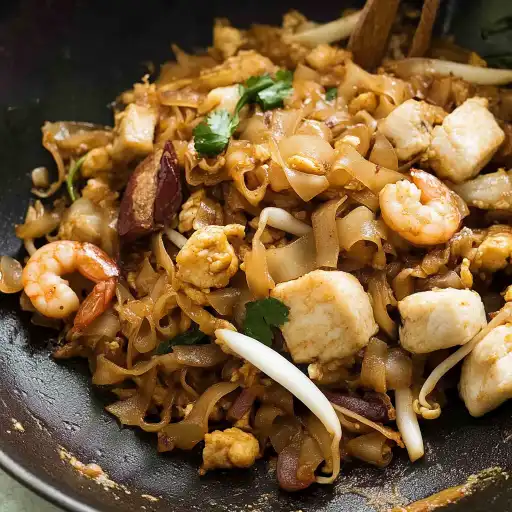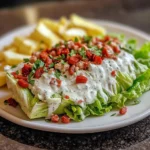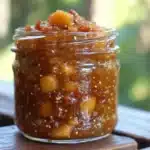Char Kway Teow, meaning “stir-fried rice cake strips,” is a quintessential Southeast Asian dish, celebrated for its vibrant medley of flavors and textures. Originating from the hawker stalls of Malaysia and Singapore, this dish has captured the hearts (and stomachs) of food enthusiasts worldwide. It’s a dish that tells a story – a story of cultural fusion, culinary ingenuity, and the simple joy of savoring a perfectly balanced meal.
Why You Will Love This Recipe
This Char Kway Teow recipe is more than just a collection of instructions; it’s a culinary adventure. Here’s why you’ll fall in love with it:
- Authentic Flavor: This recipe stays true to the traditional flavors of Char Kway Teow, using a harmonious blend of sweet, savory, and smoky notes.
- Versatile: Feel free to customize the ingredients to your liking. Add more seafood, vegetables, or adjust the spice level to suit your preferences.
- Surprisingly Easy: While it may seem intimidating at first, this recipe is surprisingly straightforward, especially with the “Easier Method” included.
- A Crowd-Pleaser: Char Kway Teow is a guaranteed hit at gatherings. Its unique flavor profile and satisfying texture make it a memorable dish for any occasion.
- A Taste of Southeast Asia: Transport yourself to the bustling streets of Southeast Asia with every bite of this flavorful dish.
Ingredients:
- 500 g / 1 lb fresh wide rice noodles
- 2 tbsp lard, or vegetable oil
- 2 tbsp vegetable oil, separated
- 10 small prawns/shrimp, shelled and deveined
- 2 garlic cloves, finely chopped
- 1 Chinese sausage / Lup Chong Sausage, sliced thinly on the diagonal
- 5 cm / 2″ piece of fried fish cake, sliced thinly
- 20 stems garlic chives, cut into 4 pieces
- 2 1/2 cups bean sprouts
- 2 eggs, whisked
Sauce:
- 5 tsp dark soy sauce
- 4 tsp light soy sauce
- 2 tsp oyster sauce
- 4 tsp kecap manis / sweet soy sauce
Preparation:
Before you begin, prepare all your ingredients and have them within reach. This dish cooks quickly, so it’s essential to be organized.
Step 1: Prepare the Noodles
Do not attempt to pull noodles apart while cold and hard – they break.
Place the whole packet in the microwave, heat on high for 1 1/2 minutes – 2 minutes until warm and pliable, not hot, turning the packet over as needed.
Handle carefully and measure out 500g/1 lb noodles into a heatproof bowl. Separate noodles stuck together.
If noodles become cold and brittle before cooking, cover with cling wrap and microwave for 30 seconds to make warm (not hot, just warm) to reduce breakage.
Step 2: Prepare the Sauce
In a small bowl, whisk together the dark soy sauce, light soy sauce, oyster sauce, and kecap manis. Set aside.
Step 3: The Base Recipe (for capable cooks)
- Heat lard and 1 tbsp oil in a wok or very large heavy based skillet over high heat. Swirl around the wok.
- When it starts smoking, add prawns. Cook for 30 seconds.
- Add garlic, stir for 10 seconds.
- Add noodles, then using both hands on the handle, toss 4 times until coated with oil (or gently fold using a spatula + wooden spoon, see video).
- Add Chinese sausage and fish cake, toss or gently fold 4 times.
- Add bean sprouts and garlic chives, toss or gently fold 6 times.
- Push everything to one side, add remaining 1 tbsp oil. Add egg and cook, moving it around until mostly set – about 1 minute. Use a wooden spoon to chop it up roughly.
- Pour Sauce over noodles, then toss to disperse Sauce through the noodles. Pause between tosses to give the noodles a chance to caramelize on the edges.
Step 4: The Easier Method (non stick skillet)
- Heat 1 tbsp oil in a large non stick skillet over high heat.
- When heated, add shrimp and cook for 1 1/2 minutes until just cooked through, then remove into bowl
- Add Chinese sausage and fish cake, and cook for 1 minute until sausage is caramelised, then add to bowl.
- Add 1 tbsp oil then add egg and cook, pushing in the edges to make a thick omelette. Once set, chop it up roughly using a wooden spoon (see video), then add to bowl.
- Add bean sprouts and cook for about 1 minute until just starting to wilt, then add to bowl.
- Add lard. Once melted and starting to smoke, add garlic then immediately add noodles. Fold gently 4 times using a spatula + wooden spoon (see video) just to disperse oil through noodles.
- Tip all the other ingredients back in plus the chives. Fold gently twice, then pour all the Sauce over.
- Gently toss 4 to 6 times to disperse the sauce, pausing in between to allow the noodles to have a chance to caramelise on the edges a bit.
Step 5: Serving
Serve immediately!
Cooking Rating:
Medium
Serving Suggestions:
- Garnish with extra bean sprouts and garlic chives for added freshness.
- Serve with a side of pickled green chilies for an extra kick.
- Enjoy as a main course for lunch or dinner.
Tips:
- Use fresh, high-quality ingredients for the best flavor.
- Don’t overcrowd the wok or skillet. Cook in batches if necessary.
- Adjust the amount of sauce to your liking.
- Serve immediately for the best texture and flavor.
- The lard adds a distinctive flavour to the dish. If unavailable, substitute with vegetable oil.
- For a vegetarian version, omit the prawns and Chinese sausage and add extra vegetables such as mushrooms or tofu.
Prep Time:
20 minutes
Cook Time:
15 minutes
Total Time:
35 minutes
Nutritional Information:
(Note: Nutritional information is an estimate and may vary based on specific ingredients and portion sizes.)
Calories:
Approximately 600-700 per serving
Protein:
25-30 grams per serving
Sodium:
Varies depending on soy sauce used. Use low-sodium soy sauce for a lower sodium content.
Conclusion:
Char Kway Teow is more than just a dish; it’s an experience. It’s a testament to the power of simple ingredients transformed into a culinary masterpiece. Whether you’re a seasoned cook or a beginner, this recipe will guide you through creating a dish that is both satisfying and unforgettable. So, gather your ingredients, fire up your wok, and embark on a culinary journey to the vibrant streets of Southeast Asia. Enjoy!
Questions and Answers About This Recipe:
Q1: Can I use dried rice noodles instead of fresh ones?
A: While fresh rice noodles are ideal for Char Kway Teow, you can use dried rice noodles as a substitute. Soak the dried noodles in warm water until they are pliable but not too soft. Be careful not to overcook them during the stir-frying process, as they can become mushy.
Q2: Can I make this recipe vegetarian?
A: Absolutely! To make a vegetarian version, simply omit the prawns and Chinese sausage. You can add extra vegetables such as mushrooms, tofu, or bok choy to compensate for the protein.
Q3: What is kecap manis, and where can I find it?
A: Kecap manis is a sweet soy sauce that is commonly used in Southeast Asian cuisine. It has a thick, syrupy consistency and a rich, molasses-like flavor. You can find kecap manis in most Asian grocery stores or in the international aisle of well-stocked supermarkets.
Q4: Can I adjust the spice level of this dish?
A: Yes, you can easily adjust the spice level of Char Kway Teow to your liking. Add a pinch of chili flakes or a dash of your favorite hot sauce to the sauce mixture. You can also serve the dish with a side of pickled green chilies for those who prefer a spicier flavor.
Q5: What is the best way to reheat leftover Char Kway Teow?
A: Leftover Char Kway Teow is best reheated in a wok or skillet over medium heat. Add a tablespoon of oil or water to prevent sticking and stir-fry until heated through. Avoid microwaving, as this can make the noodles rubbery.




